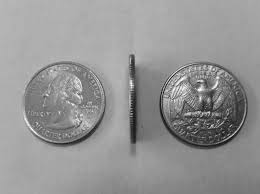3 Sides of a Coin

We are entering into another month of weekends with Prashant Iyengar, the son of BKS Iyengar and the consummate “philosopher” within our method. And, though I thought I would try to blog both classes together each weekend, coming out of the first class, as usual, there is just so much to share.
He begins by setting the foundation of his approach – differentiating the “doing of a posture” from having “usage and application within an asana”. For most of us, an asana equates to postural “doing and doing and doing until dying”. But this approach actually leaves out the practice of yoga altogether. To become yoga, there must be complete sense participation (eyes, ears, etc…) and attachment and interaction of breath and mind to every action. In yoga we must utilize the “chemical processes” within our embodiment for exploration and not just focus on the postural elements of the body for accomplishment.
To demonstrate some of our misunderstanding or disconnection of this body, mind, and breath phenomenon he used my favorite yoga example of standing in Tadasana and closing your eyes. We approach the pose with eyes wide open, limbs stretched and firm, and feet together standing in samasthiti (balanced standing). We feel steady, we feel stable and strong, and then we close our eyes. With that small change, we find very quickly that we are not as balanced and stable as we seem with our eyes open, swaying to and fro. Our sense of sight plays a HUGE roll in an experience of an asana as does our sense of hearing, touch, and the other sense organs of the tongue and the nose. We are educated within a “doing process”, but we must look deeper, “read between the lines” with mind and breath.
The metaphor of the coin came into play in a lot of different ways in this class. Very often we use the coin example referring to just two sides. We also talk about the “head” of the coin being the dominant structure. First Prashant made a note that we tend to use the body as the “head of the coin” (the dominant structure) in any asana, however BKS Iyengar referred to the “consciousness or mind-stuff (citta) as the ‘head’ of every asana”. In reality, when you look at a coin it truly has THREE sides, not just two. In yoga, the head of the coin is the mind and the tail of the coin is the breath, but the third dimension of the edge is the body. You cannot have two sides of a coin without the edge and you cannot understand the breath or the mind fully without the dimension of the body to work within.
Prashant also brought in the idea of a dollar bill being used within the hands of a wise person or an ignorant person. First of all, the dollar bill also has a head and a tail that correspond – you cannot have five dollars on one side and one dollar on the other. The mind and the breath must be used in balance. On top of that, if you give one dollar to a wise person with all the knowledge of what money is and how it can be used, that one dollar may become much more. But if given to an ignorant person with no knowledge of its use, the one dollar may not even be used for that…may become less than the paper it is printed on in fact. The practice of asana is not irrelevant or to be ignored, but we cannot be ignorant in our use of it either.
Yoga is a path of knowledge and wisdom. We must “open up the book of knowledge” for ourselves by finding the interaction of body, mind, and breath within any asana. Asana is the “ways and means to become sagacious” – the tool to become perceptive, penetrating, discerning, and knowledgeable about our Self.
Prashant left us with a literal “pause”.
The meaning of the two following sentences changes with the use of a comma…
– “His wife, who is in NY, is unwell.”
– “His wife who is in NY is unwell.”
One distinguishes one wife from his other multiple wives. And one makes clear that his one wife is in NY. The pause of a comma counts.
Prashant Oct 2020
I thought of the many memes from all my English and grammar teacher friends that point out the need for correct use of commas and apostrophes if you want to be clear in your understanding. First of all, I apologize for any of my overuse or underuse of the lovely comma. I know I am definitely guilty of faulty grammar. But I do understand the use and importance of a good and a well placed pause, we are even taught this in Teacher Training. A good pause is actually where we might find the time and the space to “read between the lines” as Prashant suggests.
As always, I look forward to tomorrow…